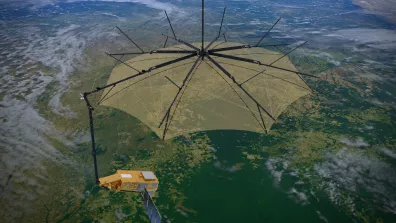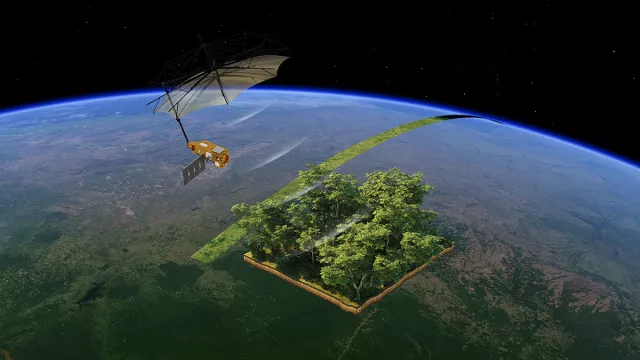The mission of the Biomass satellite scheduled to launch on 29 April 2025 will be to map forest biomass and estimate how much carbon they store. The goal is to precisely measure their impact on the carbon cycle and climate change. Biomass is ESA’s seventh Earth Explorer mission.
Key information
Key figures
- 1 instrument
- 50-to-100-m resolution
- 15 contributing French laboratories
- 12-m-diameter radar reflector
Key milestones
- 29 April 2025: Launch of Biomass
- 18 February 2015: ESA gives go-ahead for Biomass mission
- 2013: Biomass down-selected for ESA’s 7th Earth Explorer mission
Project in brief
Launched on 29 April 2025, the European Biomass mission will map biomass and forest height, as well as quantify the extent of biomass being lost each year, notably as a result of deforestation. The satellite will do a full repeat survey twice a year.
The aim is to better understand the role of the world’s forests in the carbon cycle and climate change. The satellite will also collect data on Earth’s subsurface geology and on the evolution of dry and frozen regions, for example to monitor glaciers.
To accomplish its mission, Biomass will be carrying a P-band synthetic aperture radar (SAR).
This instrument, the first of its kind to fly in space, will measure biomass in tropical, boreal and temperate forests with a resolution of 50 to 100 metres. Biomass data will also provide a 3D view of the structure of forests.
Besides France’s involvement through the CESBIO biosphere research centre and 14 other national research laboratories, the German aerospace agency DLR, Italy’s Politecnico di Milano engineering school, the Swedish defence research agency FOI, the Technical University of Denmark DTU, the California Institute of Technology (Caltech) and the University of Virginia in the United States are also contributing to the design and development of the Biomass mission.
CNES’s role
Initiated by ESA and the CESBIO biosphere research centre, a joint research unit of CNES, the French national scientific research centre CNRS, the IRD development research institute and Paul Sabatier University in Toulouse, Biomass is ESA’s seventh Earth Explorer mission.
Contacts
Biomass Project Leader
Thierry Koleck
E-mail: thierry.koleck at cnes.fr
Biomass Principal Investigator
Thuy Le Toan
E-mail: thuy.letoan at cesbio.cnes.fr
Continental Biosphere subject matter expert
Philippe Maisongrande
E-mail: philippe.maisongrande at cnes.fr
Project news



